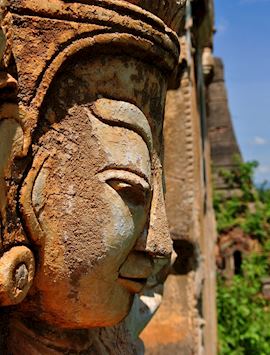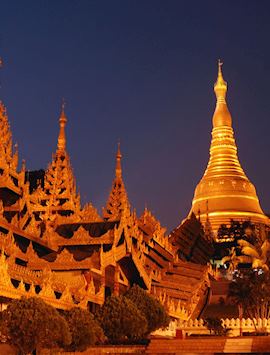By Myanmar specialist Alex
Myanmar carries an air of the exotic stronger than any of its Southeast Asian neighbors. You see it in the colors of the land, the rich red earth giving life to turquoise crops and wild sunflowers lighting up the landscape.
Walking around a local market, it's still rare to hear any foreign voices. Some 150 ethnic groups live in Myanmar, and, for many, the people are its highlight. Some of the Burmese who I’ve met along the way have become friends, and in turn introduced me to their family and friends.
Myanmar is still waking up from the dark days of its past, and today it represents how the rest of Southeast Asia was 30 or 40 years ago. Within this lies its charm. It remains relatively untainted by the trappings of the West and, for me, offers the most authentic travel experience in Southeast Asia.

Things to do in Myanmar: My selected highlights
Colonial splendor in Yangon
Most trips to Myanmar start by flying into Yangon, the former capital that's still more recognizable by its old name, Rangoon.
Yangon is starting to show signs of the cosmopolitan — I ate in a tapas bar on my last visit and more cars are purring around in the streets. But, in the colonial downtown area, the grand old buildings are pretty much untouched — a step back in time that has been lost through development in Southeast Asia’s other colonial cities.
Some of the mansions still serve as public buildings or have found new purposes as art galleries and shops. Others are ghost buildings, awaiting a new future. Where you can step inside, do so to admire the floors laid with Gothic-style Manchester tiles.
The Shwedagon Pagoda’s central golden stupa — weighted in nearly 30 tons of gold plate — is omnipresent on Yangon’s skyline. Every Burmese Buddhist must visit the temple complex at least once in their life.
I suggest visiting the Shwedagon Pagoda at sunset when the city's residents pay their respects.

Markets in Mandalay
Mandalay is the unsung hero of Myanmar, a city you can really get under the skin of, yet it’s been playing second fiddle to Yangon since the days of British colonialism. I, for one, find it equally captivating. I think it gets overlooked because it doesn’t have a colonial district, but its setting on the banks of the lackadaisical Ayeyarwady River is sublime.
Past worshipers have studded the surrounding Sagaing Hills with hundreds of temples topped with golden stupas, which glint down at you from their perches.
Mandalay's railway bazaar
The railway bazaar is my favorite of Mandalay’s many markets.
The vendors set up stall on the tracks of a working railway. As the train approaches at speed, the locals casually step back from the rails, sometimes leaving produce behind them for the train to pass straight on over. Ten seconds later and the market is back in full operation.
Aim to get to the market for 10am when the trading is in full swing and just ahead of the first train of the day. The stalls are laden with fish, fruit and vegetables, different colored blocks of curd and big bags of grubs, a delicacy when fried.

Myanmar’s go-to beach
For a beach resort in Myanmar, I’d head to Ngapali, a blissfully underdeveloped stretch of white sand beach that runs for 15 miles along the Bay of Bengal. You just don’t get many beaches like it in Southeast Asia anymore, and it’s a great place to relax at the end of a trip.
A sprinkling of hotels provides good-standard accommodation yet manages to leave a barely noticeable imprint along the long sweep of honeyed sand.
There are no traders or stalls. Essentially, this is a locals’ beach and a working one, too. The fishing village at one of the far reaches of the bay is industrious in supplying the morning catches of fish to the local restaurants to serve for lunch and dinner.

Temples at Bagan
Around 4,000 temples (and still counting) rise above the farmland plain and treeline of palms where the Ayeyarwady River turns a corner at Bagan.
Built in red brick or white stone, and often finished in gold, some of the temples in Myanmar are in a ruinous state, while others have been faithfully reconstructed.
Local people still live and farm among the structures, all that remains of an ancient city.
Most travelers to Bagan focus their efforts on visiting four or five of the bigger temples, concentrating at sunset on climbing the steps to the viewing platform of the lofty Shwesandaw temple. This proved a little vertiginous for me, and I found the lesser visited Pyathatgyi temple — still in the heart of the area — had an easier approach to the platform and a no-less impressive vista from where to watch the temples radiate in the flush of evening sun.
Some four hundred odd of the temples are decorated with colored murals inside — which are reminiscent of the Bayeux Tapestry in the scale of narratives they depict. Ask your guide to show you inside one or two, and pick out the murals from the dark with a torch.
The flat terrain lends itself to touring around the temples by bicycle or ebicycle, little mopeds which you can easily hire. On your own, you can stop and admire any passing temple that catches your eye.

Myanmar’s sacred mountaintop Buddhist site
The Kyaiktiyo Pagoda, or Golden Rock, is revered by Buddhists throughout Myanmar. It teeters on the edge of a precipice and they say a single strand of the Buddha’s hair stops it from tumbling.
Back in 2008, when a cyclone hit, it didn’t even wobble. Although, it gently rocks in the wind, as I saw when I visited.
A four-hour drive from Yangon brings you to Kyaiktiyo at the base of the mountain where the rock majestically balances. Then it’s a five-hour climb to the rock. An easier option is to ride up to the summit on a local truck.

Trekking to visit remote hill tribes
Walking and trekking in Myanmar is a great way to visit remote villages and the distinctive indigenous peoples which inhabit them. On a single trek in the countryside that surrounds Kyaingtong, a sleepy town in the far eastern Shan State, you’re likely to see four or five completely different hill tribes co-existing in close proximity.
A dazzling ethnicity of tribes, such as the Ann (noticeable for their black charcoal-stained teeth), Akha and Lahu, work the rice terraces wearing traditional dress festooned with bright ribbons and tassels, with large wicker baskets strapped to their backs.
This is a remote part of Myanmar where strangers are seldom seen. As such, the inhabitants are intensely interested in any visitor and unfailingly welcoming.
During my walk among the villages, I was invited into a house by members of the Ann people and served tea and warm peanuts while the local children watched on in wide-eyed fascination.
I’d suggest a one-day trek to explore with a local English-speaking guide.

Inle Lake
Inle Lake is quite unlike anywhere else in Myanmar. Its shallow waters stretch for 35 kilometers, an elongated teardrop of blue in the central highlands.
Hill tribe villages ring the lake, and the Intha people live in stilted villages that extend out from the lake’s shore into the water. These communities are hives of industry, and on a visit you’ll see silversmiths and blacksmiths working metal and silk, and cotton weavers working at looms in workshops below their homes.
The mix of peoples also makes for colorful markets, the highlight being the floating market that moves around the lake on a five-day rota.
Balloon ride over the lake
I was one of the first people lucky enough to take a balloon ride over the lake. From above, you get a grasp of the whole diversity of what's happening on the water below: the floating farms, the villages and the leg-rowing fishermen who navigate their boats with an oar crooked in their leg.
Inle Lake is an hour’s drive from Heho Airport, which in turn is a short flight from any of Myanmar’s main destinations. Or, by road, it’s a day's drive from Bagan or Mandalay.

Crossing the Goteik Viaduct
If you want to take a train ride in Myanmar, I’d highly recommend the rail journey between Mandalay and Lashio, the last major city on the old Myanmar Road. As the train chugs its way up through Shan State, it reaches the Goteik Viaduct, just north of the former British colonial hill station Pyin Oo Lwin.
It’s possible to join the train for an hour or so to experience crossing the viaduct, which was the second-highest railway bridge in the world on its construction in 1900.
Travel in third class, which seats you among the locals and makes for a much earthier experience in among the many local travelers, farm animals and goods that fill the train daily. The windows open wider in these carriages, too, to afford a better view as you cross the viaduct, which breaches a 300-meter deep chasm.
Start planning your trip to Myanmar
Start thinking about your experience. These itineraries are simply suggestions for how you could enjoy some of the same experiences as our specialists. They're just for inspiration, because your trip will be created around your particular tastes.
View All Tours in Myanmar




